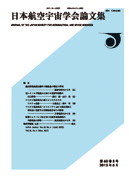All issues

Volume 51, Issue 588
Displaying 1-6 of 6 articles from this issue
- |<
- <
- 1
- >
- >|
Articles
-
Hirokazu Tahara, Atsushi Shirasaki, Manuel Martinez-SanchezArticle type: report
2003 Volume 51 Issue 588 Pages 1-9
Published: 2003
Released on J-STAGE: September 16, 2003
JOURNAL FREE ACCESSOne-dimensional Hall thruster flowfield calculation, in which axial motion of ions; axial and azimuthal motions of electrons perpendicular to magnetic field were considered, was carried out to understand the plasma features and the plasma acceleration processes. The model included first ionization by direct electron-neutral collisions, electron-neutral elastic collisions, electron-ion Coulomb collisions, Bohm diffusion (anomalous diffusion); channel wall losses of ion flux and electron energy with secondary electron emission effect. The flowfield in an acceleration channel was divided into diffusion, ionization and ion acceleration regions. Both ionization and ion acceleration were found to, intensively and efficiently, occur in their thin regions with a few millimeter thick near the acceleration channel exit. The calculated thruster performance roughly agreed with an experimental one.View full abstractDownload PDF (174K) -
Mitsuru Kurita, Takumi Okada, Yoshiaki NakamuraArticle type: report
2003 Volume 51 Issue 588 Pages 10-16
Published: 2003
Released on J-STAGE: September 16, 2003
JOURNAL FREE ACCESSThe use of pressure sensitive paint can make possible the measurement of global surface pressure distribution on a body at a time, which is different from point measurement by conventional pressure transducers. Although shock tunnels have been widely used to make hypersonic flows at low cost and to examine the flowfield around re-entry vehicles, they have a limitation of duration. The present paper proposes a new pressure sensitive paint method for hypersonic flows in shock tunnel. To realize its fast response, we developed a paint method, the results of which were compared with detailed pressure measurements by using conventional pressure transducers as well as visualizations by Schlieren photography and oil flow method. As a result, the present method was found to be useful and effective to analyze the flowfield around body in shock tunnel.View full abstractDownload PDF (671K) -
Hiroaki Hasegawa, Shinya Suga, Akinori MatsuokaArticle type: report
2003 Volume 51 Issue 588 Pages 17-22
Published: 2003
Released on J-STAGE: September 16, 2003
JOURNAL FREE ACCESSFor axial flow compressors and fans in the aircraft engines higher pressure ratio is required in order to attain the high thrust engines. In this study, the fan with the tandem cascades was introduced to increase the fan pressure ratio. The use of tandem cascades in the fan allows savings in length and weight and therefore a compact fan could be built. The design of fan with tandem cascades and the fan testing were carried out to develop the high pressure ratio fan for the Air Turbo Ramjet (ATR) propulsion system. The ATR is a combined cycle engine which performs like a turbojet engine at subsonic speeds and a ramjet at supersonic speeds. In particular, high fan pressure ratio contributes to increase the engine thrust during subsonic flight at which the engine does not make use of ram effect. The results of the fan testing indicate that the pressure ratio of 2.2 is achieved in single stage fan.View full abstractDownload PDF (190K) -
Koichi Mori, Nobuyuki Harabe, Kimiya Komurasaki, Yoshihiro ArakawaArticle type: report
2003 Volume 51 Issue 588 Pages 23-30
Published: 2003
Released on J-STAGE: September 16, 2003
JOURNAL FREE ACCESSThe energy conversion processes in producing plasma by focusing a laser pulse have been investigated. A TEA CO2 laser was used to produce plasma in quiescent air at reduced pressures and a M=2 flow. The laser supported detonation wave and the shock waves driven by plasma expansion were visualized by the shadowgraph method. The energy conversion efficiency in producing a blast wave was estimated from the shadowgraphs. As a result, in an air atmosphere, the efficiency was found at 0.4±0.1 in the case of 10J laser pulse input, and was 0.6±0.1 in the case of 4J input. Although the efficiency was not affected by the M=2 flow, it was decreased with the decrease in the ambient pressure.View full abstractDownload PDF (787K) -
Masahiro Kanazaki, Hitoshi Fujiwara, Shigeru Obayashi, Kazuhiro Nakaha ...Article type: report
2003 Volume 51 Issue 588 Pages 31-35
Published: 2003
Released on J-STAGE: September 16, 2003
JOURNAL FREE ACCESSThis paper presents numerical simulation of flowfields around a supersonic transport aircraft with integrated engine nacelles. In this study, flowfields were simulated by solving the Euler equations with the unstructured grid method for handling the complex geometry. To simulate intake flows at actual flight conditions, a bump was introduced inside the nacelle. The effect of nacelle mass flow ratios on overall aerodynamic performance was investigated in detail by changing bump heights. The spillage drag was calculated and found to have a large impact on the total drag. Computed results showed excellent agreements with wind tunnel data obtained at National Aerospace Laboratory of Japan.View full abstractDownload PDF (370K) -
Hiromitsu Senba, Hideo Matsuo, Hidehiko Takahashi, Shintarou Yoshimoto ...Article type: report
2003 Volume 51 Issue 588 Pages 36-44
Published: 2003
Released on J-STAGE: September 16, 2003
JOURNAL FREE ACCESSA method is proposed to control the variation of cushion pressure of SES oscillating vertically. The peripheral nozzle is attached along the periphery and swings changing the discharge angle. The angle varies in accordance with the motion of the craft. A method is proposed to analyze the mechanism of this setup. The result is compared with experiments to show the agreement of the two results. It has been shown both theoretically and experimentally that the variation of the cushion pressure is effectively controlled adjusting the amplitude and the phase of the swinging motion of the nozzle.View full abstractDownload PDF (590K)
- |<
- <
- 1
- >
- >|